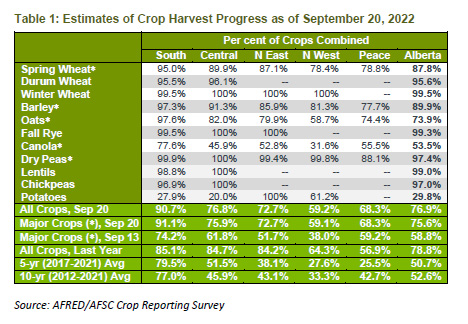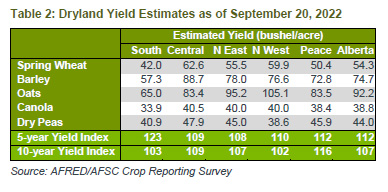Crop Conditions - September 20, 2022
This week’s crop report confirms ongoing harvest progress with above average yield and quality expectations. As at September 20, eighty-seven per cent of all crops were swathed or combined with an expected 10-year yield index of 107 and with grading expectations of the provincial wheat, barley, canola, and pea crops ahead of 10-year averages.
Combining across the province on all crops is now 77 per cent complete and well ahead of the 10-year average of 53 per cent. Two weeks ago on September 6, combining of all crops was 37 per cent complete. Alberta farmers have been able to harvest 40 per cent of all crops in the past two weeks. Specifically this past week, the North East and North West made significant harvest progress with both increasing combine completion on major crops by 21 per cent through the week. However, as can be seen on the map below to the right, the Peace region received meaningful rainfall which slowed last week’s progress. Overall, for this time in the season, the South and Peace are ahead of harvest compared to this time last year but Central, North East and North West regions are behind. Across the province, combine completion on all crops is relatively unchanged year-over-year (79 per cent at this time last year). Potatoes are the only crop significantly behind long-term averages for harvest completion.

Dryland yields are expected to index at 112 and 107 on five and 10-year indices respectively. Barley, oats, lentils chickpeas, and flax are outperforming and are all expected above 120% of their five-year normals. Of all 11 crops listed in Table 1, none have yield expectations below their five-year averages.
Irrigated yield expectations are, as expected, much less variable relative to their long-term normals, with most crops ranging in expectations from 98 to 103 per cent of normal. Chickpeas and flax are the notable irrigated exceptions with irrigated chickpeas expected at only 91 per cent of five-year average and irrigated flax outperforming at 130 per cent of five-year yield expectations. Notable for chickpeas is that irrigated chickpeas have a 4.2 bu/acre lower yield expectation than dryland chickpeas in the South (where all irrigated chickpeas are reported). Irrigated sugar beets in the South are expected at relative average yields with a 103 five-year index.

Quality expectations are also being reported favorably on major crops relative to long-term normal with exception of durum. Hard Red Spring Wheat is expected at 68 per cent 1 CW (54 per cent on five-year average) and is reported in particularly high quality in the Peace. Barley, canola, and dry pea quality expectations are modestly ahead of their long-term averages and oats marginally behind long-term normal quality. Durum is the notable exception with a quality downgrade relative to normal, as 12 per cent more than normal of the total provincial crop is expected at 2 CW grade.
Hay production across the province for the combined growing season is behind long-term average. Yields across the province averaged 1.6 t/acre on dryland first cut (1.5 on 10-year average), 0.9 t/acre on dryland second cut (1.1 on 10-year average), 2.1 t/ac on irrigated first cut (2.4 on 10-year average) and 1.5 t/acre on irrigated second cut (1.8 on 10-year average). Pastures are more marginal than normal with 73 per cent of all pasture rated as poor or fair (55 per cent on 10-year average).

Deteriorating soil moisture trends continue, with exception of the Peace region which received meaningful precipitation over the past week. As shown in the two maps below, near normal precipitation in this growing season helped deliver on the above average yields reported for 2022; however, soils are now back at pre-June low soil moisture levels. The map on the right shows large areas of the province now back to ‘moderately low’ to ‘very low’ soil moisture levels relative to long-term normal. Many areas of the province, with exception of the Peace, have received less than 30 mm of rain since late July and a drying trend persists with areas around Edmonton, Bonneville, Red Deer, Olds, and Medicine Hat having dry conditions that occur only once in 25 years. June rain resulted in the above reported favorable yields for this growing season but roughly 70 per cent of the province is now back to below normal soil moisture. Both fall and winter precipitation will now be looked to for next year.
Moisture Report - September 21, 2022
Regional Assessments:
Region One: South (Strathmore, Lethbridge, Medicine Hat, Foremost)
- Overall harvest is nearing completion and crop reporters are communicating hopes for post-harvest precipitation.
- In this region, 91 per cent of the crops are in the bin, three per cent are in swath and six per cent are standing. All crops are over 95 per cent combined with exception of canola (78 per cent), flax (83 per cent), potatoes (28 per cent), dry beans (65 per cent) and sugar beets (seven percent).
- Surface soil moisture conditions (sub-surface shown in brackets) are rated as 41 (52) per cent poor, 48 (37) per cent fair, 10 (11) per cent good and one (zero) per cent excellent.
Region Two: Central (Rimbey, Airdrie, Coronation, Oyen)
- Significantly the highest barley quality region of the province with nearly 50 per cent expected at malt grade.
- About 77 per cent of crops are in the bin, 13 per cent are in swath and 10 per cent remain standing. Pulses are all reported as 100 per cent combined, whereas canola is only 46 per cent combined, flax 50 per cent and potatoes 20 per cent.
- Surface soil moisture conditions (sub-surface shown in brackets) are rated as seven (15) per cent poor, 42 (44) per cent fair, 46 (40) per cent good and four (zero) per cent excellent.
Region Three: North East (Smoky Lake, Vermilion, Camrose, Provost)
- Barley and peas largely expected of lower quality that provincial average but wheat and canola in the North East are of very high quality.
- About 73 per cent of crops are in the bin, 14 per cent are in swath and 13 per cent remain standing. Canola and flax are 53 and 49 per cent combined respectively.
- Surface soil moisture conditions (sub-surface shown in brackets) are rated as 31 (22) per cent poor, 33 (36) per cent fair, 35 (39) per cent good and one (four) per cent excellent.
Region Four: North West (Barrhead, Edmonton, Leduc, Drayton Valley, Athabasca)
- Higher yield variability but quality grains are being reported in the North West. Some late season, light hail damage is reported along with dropping temperatures and a localized fall frost.
- Almost 59 per cent of the crops are in the bin, 21 per cent are in swath and 20 per cent remain standing. Pea harvest is complete whereas oats and canola have the most acreage remaining with 59 and 32 per cent respectively combined.
- Surface soil moisture conditions (sub-surface shown in brackets) are rated as 13 (two) per cent poor, 42 (21) per cent fair, 42 (72) per cent good and four (four) per cent excellent.
Region Five: Peace (Fairview, Falher, Grande Prairie, Valleyview)
- Large areas of the Peace region received 30-70 mm of rain over the past week and despite the rain, combining has progressed from 20 per cent to 68 per cent in the past two weeks.
- Currently, about 68 per cent of crops are in the bin, 10 per cent are in swath and 22 per cent are standing. Dry peas are 88 per cent combined. Spring wheat, barley, and oats are all roughly 75 per cent combined, whereas canola is 56 per cent combined.
- The Peace region received meaningful rain in the past week and surface soil moisture reports relative to sub-surface moisture highlight that. Surface soil moisture conditions (sub-surface shown in brackets) are rated as two (42) per cent poor, six (19) per cent fair, 49 (39) per cent good and 44 (zero) per cent excellent.
Agricultural Financial Services Corporation
Research and Innovation
Lacombe, AB
Stuart Chutter - Product Coordinator - schutter@afsc.ca
Contact Us
Saddle Hills
Junction of Hwy 49 & Secondary Hwy 725
RR1, Spirit River AB
T0H 3G0
T. 780-864-3760
Fax 780-864-3904
Toll-free 1-888-864-3760
frontdesk@saddlehills.ab.ca
Sign up to our Newsletter
Stay up to date on the Saddle Hills activities, events, programs and operations by subscribing to our eNewsletters.
